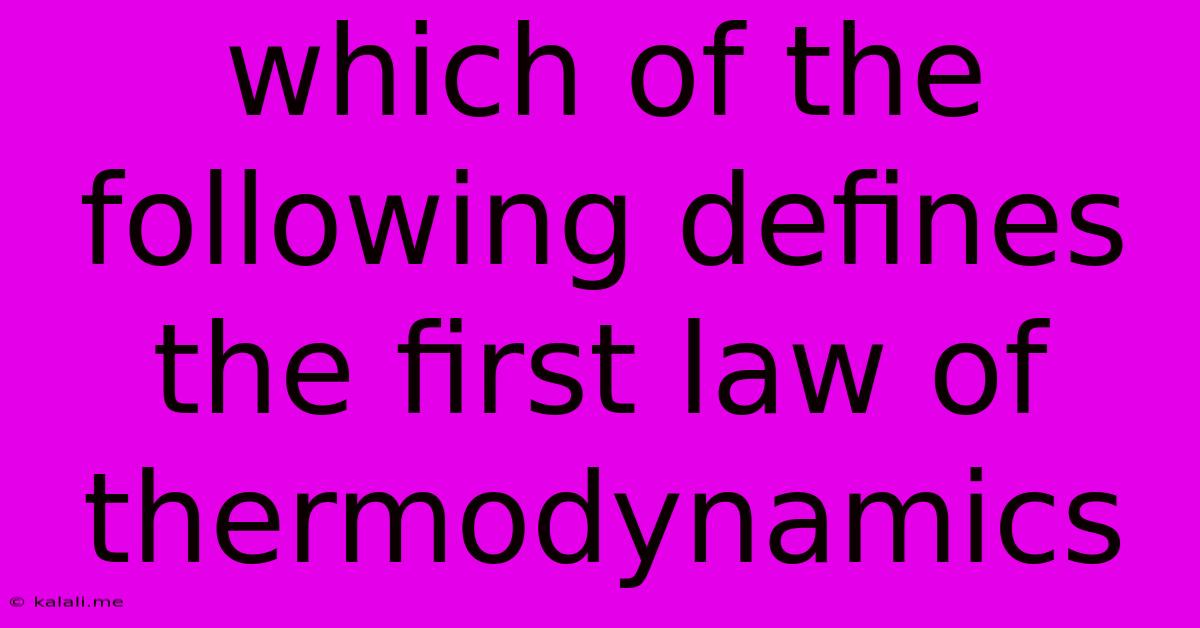Which Of The Following Defines The First Law Of Thermodynamics
Kalali
Jun 15, 2025 · 3 min read

Table of Contents
Which of the Following Defines the First Law of Thermodynamics?
The first law of thermodynamics, also known as the law of conservation of energy, is a fundamental principle in physics. It dictates how energy is transferred and transformed within a system. Understanding this law is crucial for comprehending various physical processes, from simple heat transfer to complex chemical reactions. This article explores the first law and clarifies which statement best defines it. We'll also delve into common misconceptions and related concepts.
The first law of thermodynamics essentially states that energy cannot be created or destroyed, only transformed from one form to another. This means the total energy of an isolated system remains constant over time. While energy can change forms – for example, from chemical energy to thermal energy or mechanical energy to electrical energy – the total amount remains the same.
Now, let's consider how this principle is expressed mathematically. The most common representation is:
ΔU = Q - W
Where:
- ΔU represents the change in internal energy of the system. Internal energy encompasses all forms of energy within the system, including kinetic energy of molecules, potential energy due to intermolecular forces, and chemical energy stored in bonds.
- Q represents the heat added to the system. Heat is the transfer of thermal energy from a hotter body to a colder body.
- W represents the work done by the system. Work is done when a force causes a displacement. In thermodynamics, work often involves changes in volume against external pressure.
Therefore, a statement accurately defining the first law of thermodynamics would express the conservation of energy and its mathematical relationship. Options that only mention energy transformation without quantifying it, or those focusing solely on heat transfer, would be incomplete or inaccurate. A complete definition requires the understanding that the change in a system's internal energy is equal to the net heat transfer into the system minus the work done by the system.
Let's look at some examples of statements and analyze their accuracy in defining the first law:
Correct Statements:
- "The total energy of an isolated system remains constant; energy can be transformed from one form to another, but it cannot be created or destroyed." This statement clearly expresses the core concept of conservation of energy.
- "The change in internal energy of a system is equal to the heat added to the system minus the work done by the system (ΔU = Q - W)." This statement utilizes the mathematical formulation, making it a precise definition.
Incorrect Statements (Examples):
- "Heat always flows from a hotter object to a colder object." This is a statement related to the second law of thermodynamics, concerning entropy.
- "Energy can be created but not destroyed." This is fundamentally incorrect, contradicting the core principle of the first law.
- "The internal energy of a system is always constant." This is untrue, as internal energy changes when heat is transferred or work is done.
Conclusion:
The first law of thermodynamics is a cornerstone of physics, emphasizing the conservation of energy. Accurate definitions must encompass both the qualitative aspect of energy transformation and the quantitative relationship between internal energy change, heat transfer, and work. By understanding this law and its mathematical representation, you gain a deeper comprehension of energy dynamics in various physical and chemical processes. Remember that the correct statement will accurately reflect the conservation of energy and incorporate the equation ΔU = Q - W.
Latest Posts
Latest Posts
-
What Earthquake Waves Cause The Most Damage
Jun 15, 2025
-
The Weight Of An Object Is
Jun 15, 2025
-
Similarities Between A Square And A Rhombus
Jun 15, 2025
-
Moving Decimals To The Left Or Right
Jun 15, 2025
-
A Manometer Is Used To Measure
Jun 15, 2025
Related Post
Thank you for visiting our website which covers about Which Of The Following Defines The First Law Of Thermodynamics . We hope the information provided has been useful to you. Feel free to contact us if you have any questions or need further assistance. See you next time and don't miss to bookmark.